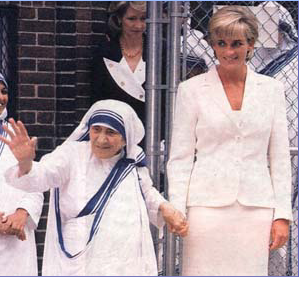P.J.
0
Remembering Diana
Humanitarian work played an important part in the Princess' life, both at home and abroad.

Her interests were reflected in the organisations of which she was Patron or President.
These included the Great Ormond Street Hospital for Sick Children in London and the Royal Marsden Hospital, which specialises in the treatment of cancer. Her patronages also included Centrepoint, an organisation working with the homeless, The National Aids Trust and The Leprosy Mission.
The Princess's love of the arts was underlined by her involvement as Patron of the English National Ballet. During her lifetime she was at some time patron of an additional 100 charities.
She made many visits to North America, visiting hospices, schools, charities and fundraising galas, and touched the lives of many wherever she went. Other major overseas visits included Angola, Australia, Bosnia, Egypt, India, Pakistan, and many European countries.
The Princess spoke out on a wide range of issues and used her high profile to raise awareness as well as funds for charitable causes. She is rightly recognised and respected today as a true humanitarian.
Connecting with people
The Princess is remembered by everyone she met for her warmth and genuine interest in their situation and difficulties. She threw herself into her charity work in a very personal way, spending countless hours listening to the individual stories and problems of the people she visited.
She had the ability to make everybody feel special, in particular vulnerable young people who were touched by her warmth and affection. In 1984, she became President of Barnardo's, a British charity which helps the most vulnerable children and young people transform their lives and fulfil their potential.
She also had a natural empathy with people who were close to death or those who had lost a loved one - something which was clear through her visits to hospitals and hospices in the UK and abroad.
She described her work with the Royal Brompton Hospital, London, like this: 'I make the trips at least three times a week, and spend up to four hours at a time with patients holding their hands and talking to them. Some of them will live and some will die, but they all need to be loved while they are here. I try to be there for them.'
In February 1992 the Princess visited Mother Teresa's Hospice for the Sick and Dying in Kolkata, India, and visited every one of the 50 patients who were close to death. In Rome shortly afterwards, and later in London and New York, she met Mother Teresa and the two formed a strong personal connection.
http://www.dianaprincessofwalesmemorialfund.org/humanitarian-work
http://mapeel.blogspot.com/2007/09/two-women-for-ages.html
Humanitarian work played an important part in the Princess' life, both at home and abroad.

Her interests were reflected in the organisations of which she was Patron or President.
These included the Great Ormond Street Hospital for Sick Children in London and the Royal Marsden Hospital, which specialises in the treatment of cancer. Her patronages also included Centrepoint, an organisation working with the homeless, The National Aids Trust and The Leprosy Mission.
The Princess's love of the arts was underlined by her involvement as Patron of the English National Ballet. During her lifetime she was at some time patron of an additional 100 charities.
She made many visits to North America, visiting hospices, schools, charities and fundraising galas, and touched the lives of many wherever she went. Other major overseas visits included Angola, Australia, Bosnia, Egypt, India, Pakistan, and many European countries.
The Princess spoke out on a wide range of issues and used her high profile to raise awareness as well as funds for charitable causes. She is rightly recognised and respected today as a true humanitarian.
Connecting with people
The Princess is remembered by everyone she met for her warmth and genuine interest in their situation and difficulties. She threw herself into her charity work in a very personal way, spending countless hours listening to the individual stories and problems of the people she visited.
She had the ability to make everybody feel special, in particular vulnerable young people who were touched by her warmth and affection. In 1984, she became President of Barnardo's, a British charity which helps the most vulnerable children and young people transform their lives and fulfil their potential.
She also had a natural empathy with people who were close to death or those who had lost a loved one - something which was clear through her visits to hospitals and hospices in the UK and abroad.
She described her work with the Royal Brompton Hospital, London, like this: 'I make the trips at least three times a week, and spend up to four hours at a time with patients holding their hands and talking to them. Some of them will live and some will die, but they all need to be loved while they are here. I try to be there for them.'
In February 1992 the Princess visited Mother Teresa's Hospice for the Sick and Dying in Kolkata, India, and visited every one of the 50 patients who were close to death. In Rome shortly afterwards, and later in London and New York, she met Mother Teresa and the two formed a strong personal connection.
http://www.dianaprincessofwalesmemorialfund.org/humanitarian-work
http://mapeel.blogspot.com/2007/09/two-women-for-ages.html
Last edited:
